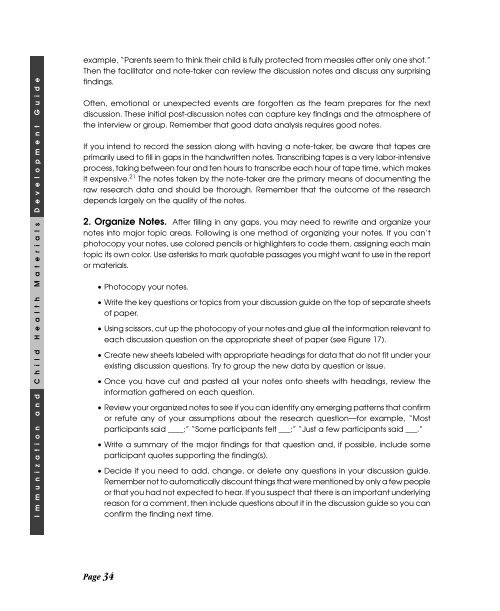Immunization and child health materials development guide pdf
Immunization and child health materials development guide pdf
Immunization and child health materials development guide pdf
You also want an ePaper? Increase the reach of your titles
YUMPU automatically turns print PDFs into web optimized ePapers that Google loves.
example, “Parents seem to think their <strong>child</strong> is fully protected from measles after only one shot.”<br />
Then the facilitator <strong>and</strong> note-taker can review the discussion notes <strong>and</strong> discuss any surprising<br />
findings.<br />
Often, emotional or unexpected events are forgotten as the team prepares for the next<br />
discussion. These initial post-discussion notes can capture key findings <strong>and</strong> the atmosphere of<br />
the interview or group. Remember that good data analysis requires good notes.<br />
If you intend to record the session along with having a note-taker, be aware that tapes are<br />
primarily used to fill in gaps in the h<strong>and</strong>written notes. Transcribing tapes is a very labor-intensive<br />
process, taking between four <strong>and</strong> ten hours to transcribe each hour of tape time, which makes<br />
it expensive. 21 The notes taken by the note-taker are the primary means of documenting the<br />
raw research data <strong>and</strong> should be thorough. Remember that the outcome of the research<br />
depends largely on the quality of the notes.<br />
2. Organize Notes. After filling in any gaps, you may need to rewrite <strong>and</strong> organize your<br />
notes into major topic areas. Following is one method of organizing your notes. If you can’t<br />
photocopy your notes, use colored pencils or highlighters to code them, assigning each main<br />
topic its own color. Use asterisks to mark quotable passages you might want to use in the report<br />
or <strong>materials</strong>.<br />
• Photocopy your notes.<br />
• Write the key questions or topics from your discussion <strong>guide</strong> on the top of separate sheets<br />
of paper.<br />
• Using scissors, cut up the photocopy of your notes <strong>and</strong> glue all the information relevant to<br />
each discussion question on the appropriate sheet of paper (see Figure 17).<br />
• Create new sheets labeled with appropriate headings for data that do not fit under your<br />
existing discussion questions. Try to group the new data by question or issue.<br />
• Once you have cut <strong>and</strong> pasted all your notes onto sheets with headings, review the<br />
information gathered on each question.<br />
• Review your organized notes to see if you can identify any emerging patterns that confirm<br />
or refute any of your assumptions about the research question—for example, “Most<br />
participants said ____;” “Some participants felt ___;” “Just a few participants said ___.”<br />
• Write a summary of the major findings for that question <strong>and</strong>, if possible, include some<br />
participant quotes supporting the finding(s).<br />
• Decide if you need to add, change, or delete any questions in your discussion <strong>guide</strong>.<br />
Remember not to automatically discount things that were mentioned by only a few people<br />
or that you had not expected to hear. If you suspect that there is an important underlying<br />
reason for a comment, then include questions about it in the discussion <strong>guide</strong> so you can<br />
confirm the finding next time.<br />
Page 34

















